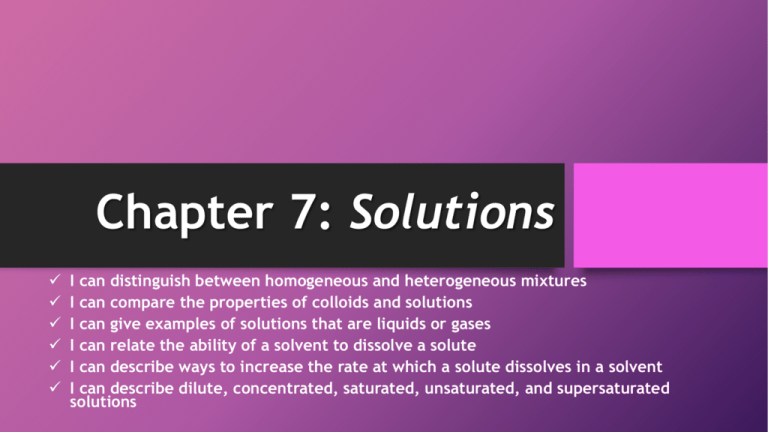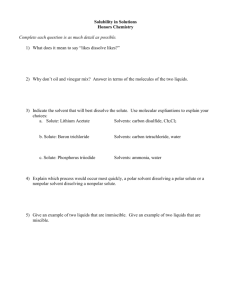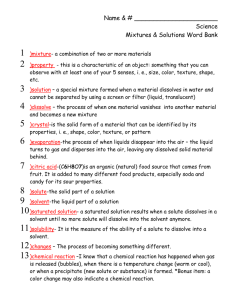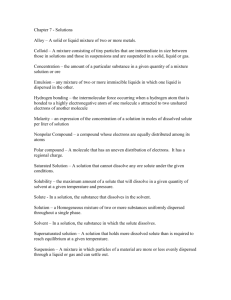Chapter 7: Solutions
advertisement

Chapter 7: Solutions I can distinguish between homogeneous and heterogeneous mixtures I can compare the properties of colloids and solutions I can give examples of solutions that are liquids or gases I can relate the ability of a solvent to dissolve a solute I can describe ways to increase the rate at which a solute dissolves in a solvent I can describe dilute, concentrated, saturated, unsaturated, and supersaturated solutions Solutions A solution is a homogeneous mixture composed of only one phase. • They can be solid, liquid or gaseous. Important Vocabulary this Chapter Homogeneous Mixture – a mixture that is the same throughout • It is all the same color, with no pieces or parts that look different Solution – A homogeneous mixture of two or more substances that’s are spread throughout Solute – Helps make a solution, this is what dissolves (usually solid) in the solution Solvent – Helps make a solution, this is what makes the solute dissolve (usually liquid) in the solution Parts of a Solution (two parts = solvent & solute) Solvent: a substance that dissolves a solute in a solution Water is called the universal solvent because it dissolves more substances than any other solvent Example: Water Solute: The substance that is dissolved The “thing” disappearing Example: Sugar There are 3 Types of Solutions Saturated (contains all the solute it can hold at a given temperature) Unsaturated (can still dissolve more solute) Supersaturated (contains more solute than it would normally at a given temperature) Special Names for Everything! There are also different names for the different types of homogenous mixtures. Solution is the general term used to describe homogenous mixtures with small particles. Colloids – are solutions with bigger particles. • Colloids are usually foggy or milky when you look at them. • In fact, milk is an colloid and fog is a colloid! What Changes the Speed of Solubility? Concentration • The solute and solvent interact with each other until the concentration of the two substances is equal throughout the system. Temperature • In general more solute dissolves in a solute with higher temperatures • Have more kinetic energy to overcome the attractive forces between bonds Stirring • Stirring will increase the rate of dissolving Particle Size • Larger particles take longer to dissolve Pressure • More pressure causes solutes to dissolve faster Are Solutions Always Liquids? No! • Solutions can also be gases dissolved in liquids, such as carbonated water or pop! How Can You Separate a Solution? If you wanted to separate a solution, how could you do it? • Add Heat Remove the solute by adding heat This evaporates the solvent, leaving the solute • Distilling Only the solvent remains, separating out the solute • Filtering If the solution is supersaturated, you can remove the remaining solid by using filter paper to catch the solid while the liquid falls through Can You Dissolve More Solute in Warm or Cool Water? • The cold water can’t dissolve as much as the hot water • When the solution can no longer dissolve the solute it becomes a 'saturated solution', this means that the solute starts forming on the bottom of the container • The reason the hot water dissolves more is because it has faster moving molecules which are spread further apart than the molecules in the cold water. With bigger gaps between the molecules in the hot water, more solute molecules can fit in between.






